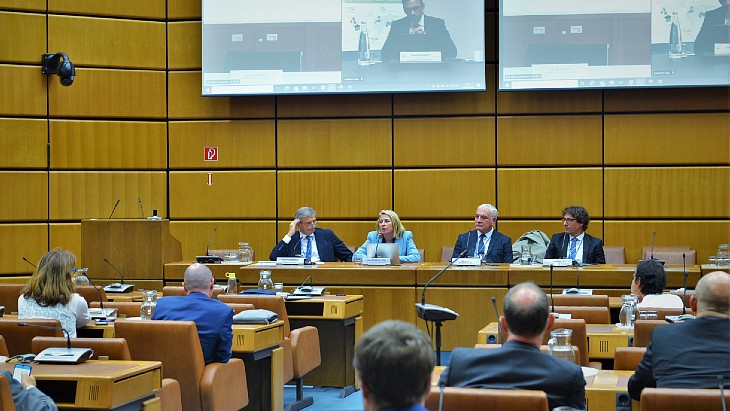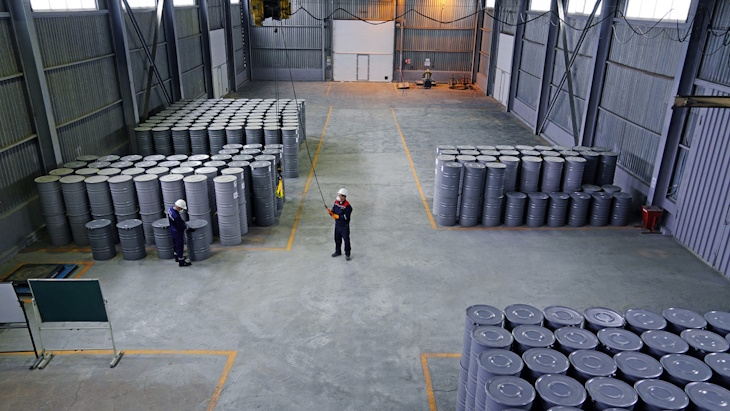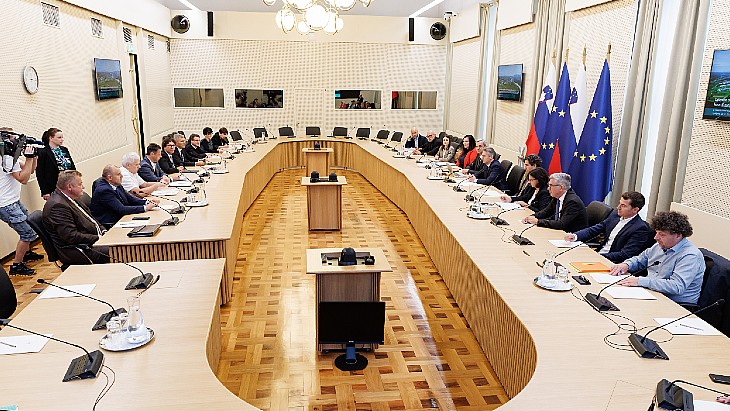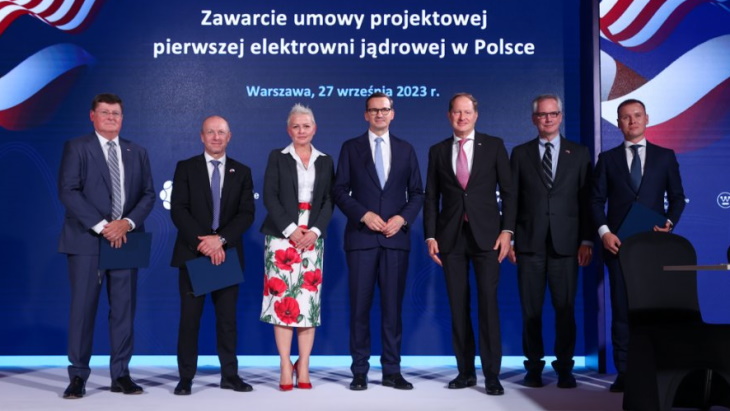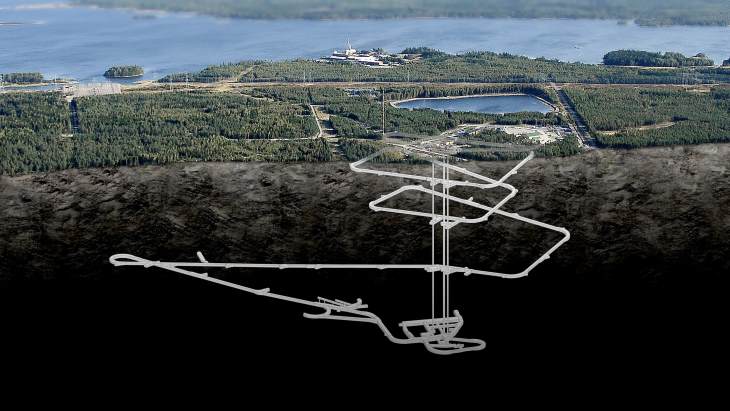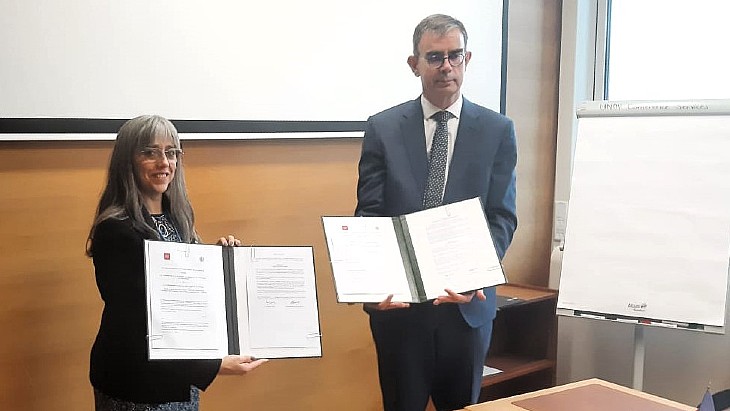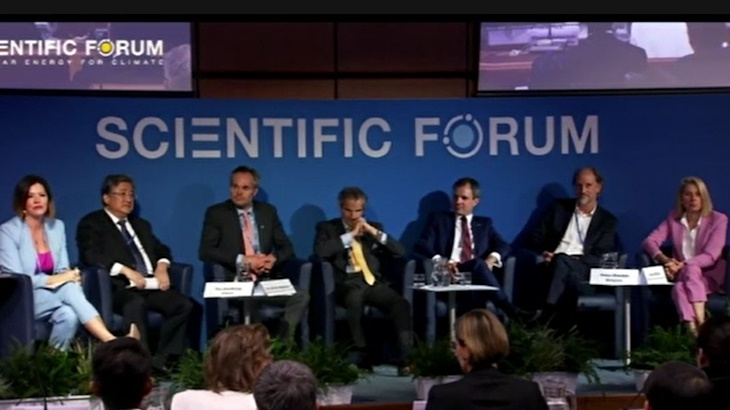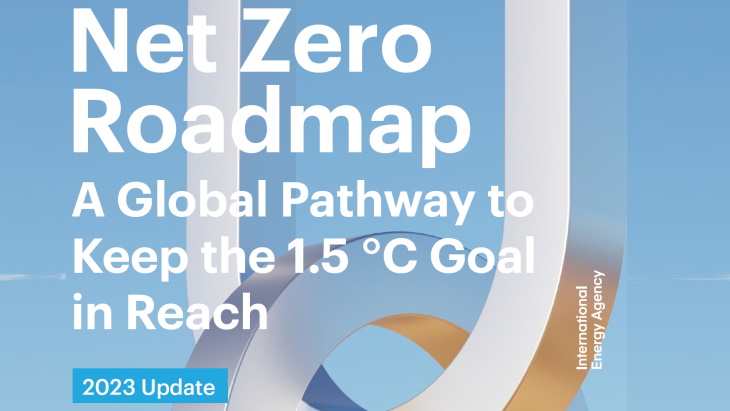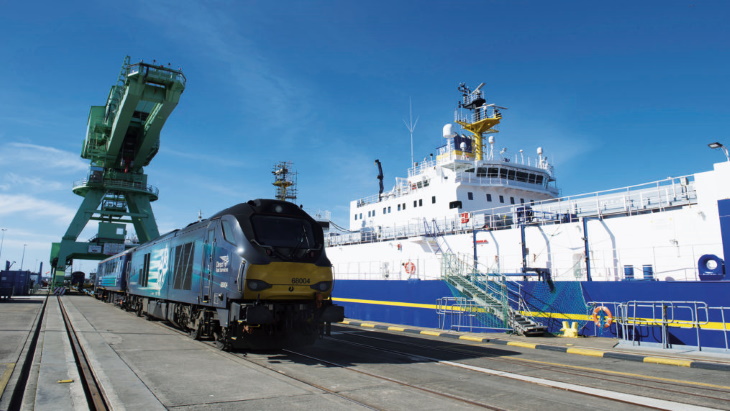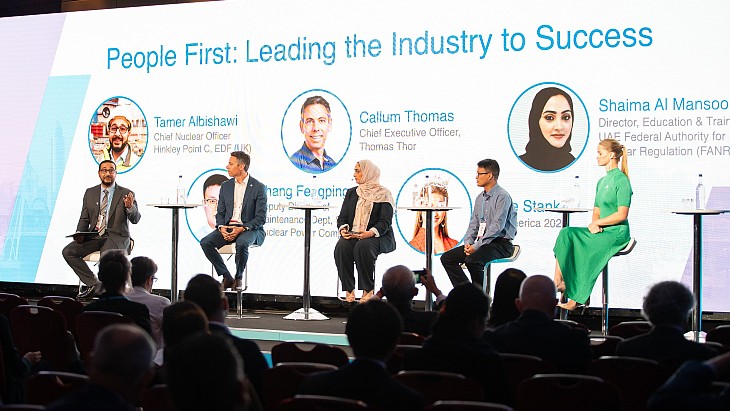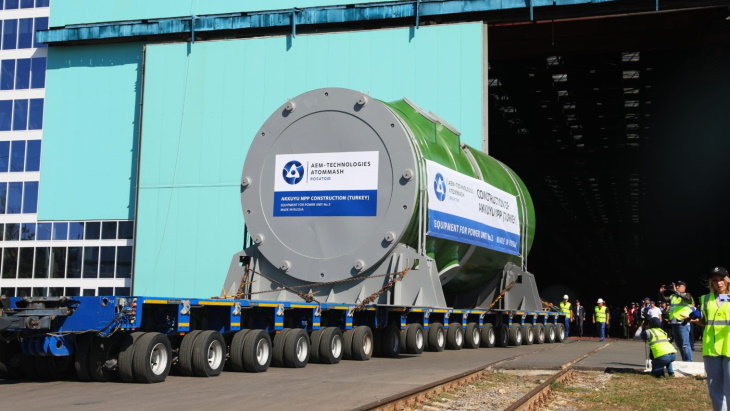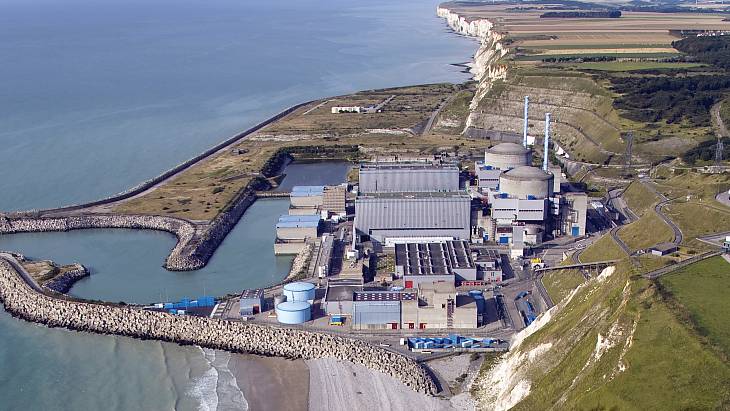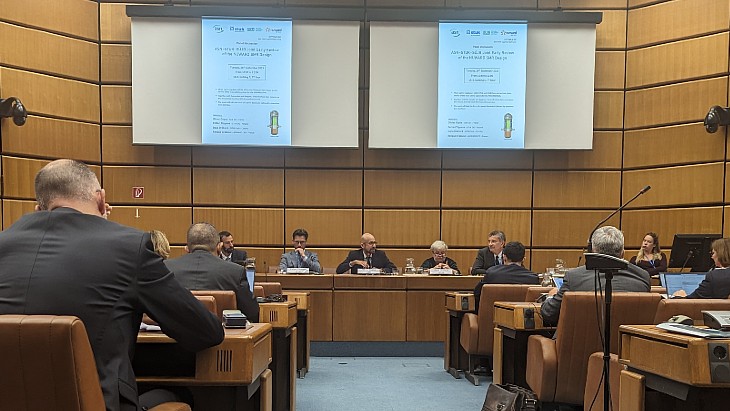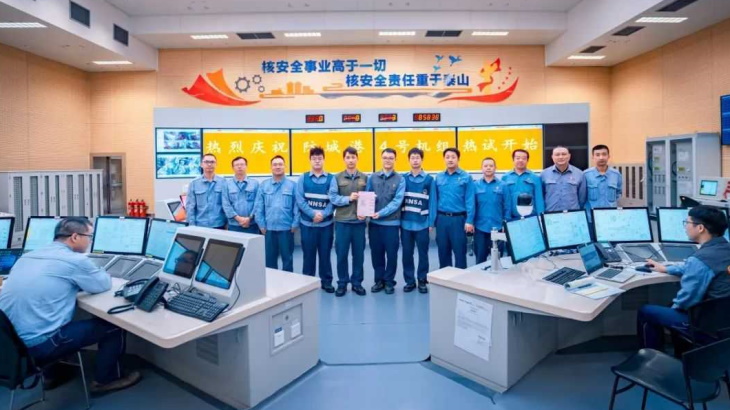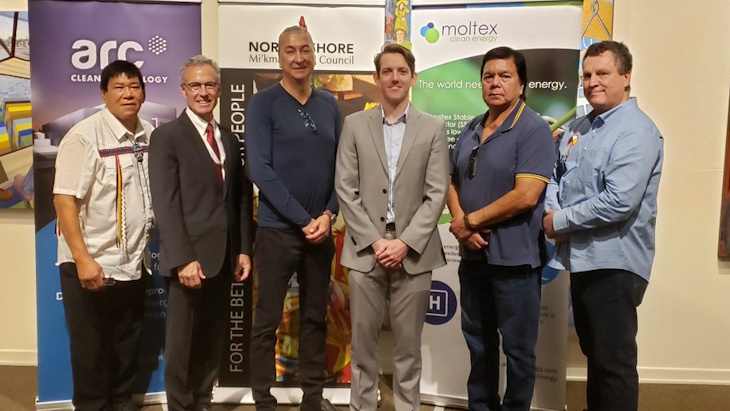Source: https://www.world-nuclear-news.org/Articles/More-countries-to-join-Nuward-SMR-joint-early-revi
The pilot phase of the joint early regulatory review of France's Nuward small modular reactor design has led to positive lessons for all sides, with three more European regulators set to join the next phase, a meeting at the 67th International Atomic Energy Agency General Conference has been told.
The session featured Dana Drabova from the Czech State Office for Nuclear Safety (SÚJB), Olivier Gupta of France's Autorité de Sûreté Nucléaire (ASN) and Petteri Tippana from Finland's Radiation and Nuclear Safety Authority (STUK) - the three national regulators taking part in the review - as well as Renaud Crassous, president and CEO of Nuward, which was spun off into a separate company by its parent EDF earlier this year.
The main objectives of the multilateral review were to identify key issues towards the hypothetical licensing of a Nuward SMR in the three countries, and to identify divergences and convergences between the regulatory frameworks in these countries - it was not intended to replace any future licensing review of any participating regulator.
Crassous said the process had been a positive one for Nuward, allowing early feedback for its designers, and allowing discussion of the differences in regulations. He noted there were three levels in differences in regulations, saying that on international principles "the regulators converged quite easily". The second layer was the history of regulation in a country and how they had interpreted and built a national approach and implemented the global principles "and this was a precise lesson learned from this project", he said.
"And there was also the underlying layer of all the national regulations concerning things that are not nuclear at all, such as fire regulation, or the size of doors, which looks quite simple when we talk about it but which is very difficult to change when we have a full design of a plant at the end and we move to another country - that is not a part we have discussed in this process but it will be of some significance," he told the session.
"And we know that, because of this underlying layer, it is still a dream to have a unique design that will fit another country - but, still, the progress we made on the second layer and to understand the different approaches to safety, the safety case and approaches in the countries we worked with have reassured us that many of the choices we have made have been validated by the discussion and we are confident we can keep it on track," he added.
He said there was still work to be done to "be on the edge between the different regulators" and added that the Nuward team also felt it was a success and was helping produce a new process with wider benefits to the wider international nuclear sector.
The joint early review does not approve the design of the SMR but it allows discussion between different countries' regulators and the reactor designer in an effort to try to smooth the process as much as possible through future regulatory and licensing processes as part of the goal of getting as close as possible to a design that can be standardised across national borders.
The three national regulators taking part came from countries where there is interest in deploying a Nuward SMR - whose pilot plant's first concrete target date is 2030. Session chair, Luc Chanial, from ASN, said the first phase had been successful enough to create interest from other regulators and in phase two three more regulators are set to be joining - Poland's National Atomic Energy Agency (Państwowa Agencja Atomistyki, PAA), the Swedish Radiation Safety Authority (SSM) and Netherlands' Authority for Nuclear Safety and Radiation Protection (ANVS).
Early review reports
Also on Tuesday, the three regulators published their report on the first phase of the review - the NUWARD SMR Joint Early Review Pilot Phase Closure Report - and Nuward also published its NUWARD SMR Joint Early Review Summary Report.
In their report, the regulators said "this initiative provided room for sharing of knowledge, experience and detailed national practices on topics which present high stakes for safety and which are crucial in the licensing process. It also enabled regulators to acquaint with an SMR design, and thus to anticipate the main regulatory and technical challenges. For the vendor, it enabled it to receive timely feedback from the regulators on topics of the highest importance for its design, when modifications are still relatively easy to be made with the objective to develop a standardised design with a level of safety consistent with regulators’ expectations, and thus more likely to be accepted by several countries in the future. This exercise also showed that differences in regulatory frameworks don’t always need to be addressed through design changes."
"This kind of cooperation appears to be an effective and efficient way to move towards an increased standardisation of reactor designs, and also facilitates harmonisation of regulatory requirements, regulators’ expectations and practices on a voluntary basis, which preserves national sovereignty and independence."
In its "lessons learned" section it says: "The initiative preserves each regulator’s independence and sovereignty, as the joint synthesis enables to carry both common and individual views. The fact that the review was based on national regulatory frameworks, instead of a list of common acceptance criteria did not constrain the review and contributed to the independence and sovereignty of each regulator. As the joint early review initiative does not lead to regulatory binding decisions, it enables more open discussions between the regulators and the vendor. Also, it enables to provide timelier feedback to the vendor through the joint synthesis compared to official processes in each country."
It said that those taking part gained "useful insights on each other's regulatory approaches" and therefore had "the opportunity to consider evolutions of their national regulatory framework".
The report also set out some insights into what views the regulators had taken of the reactor's design. and areas where the three regulators diverged and suggested that could feed it into the design. It noted that "the cooling of the reactor pools and spent fuel pool is different from the one currently used in the French fleet of nuclear power plants and recommended by ASN for the design of these reactors. The discussions held with the working group and Nuward SMR will pave the way for further assessment of this strategy in the framework of the safety options file assessment".
In its report on the joint early review, Nuward said its intention is "to develop a standardised design, suitable and licensable in multiple countries" and the review was one of a number of measures to try to embed international regulatory requirements within the design.
The six areas covered during the year-long review were:
- The general safety objectives.
- The list of design basis conditions and design extension conditions
- The use of passive cooling systems
- The development plan for computer codes
- The integration of two reactor units in a single facility
- The Probabilistic Safety Assessment approach
It said: "The insights for the Nuward team have been numerous, relevant and useful for the Nuward SMR development. They will feed the rationale for decisions on some topics as part of the on-going Basic Design phase of the project, in order to see if a more holistic and centralised approach to certain aspects can be built into the Nuward SMR model. Examples of topics include dose limits and radiological consequences limitation objectives with respect to severe accident, DEC-A definition and selection, consideration of DBC in combination with loss of offsite power, and the classification approach for systems/structures/components."
The timing of such reviews was a point included in both the regulators' and the Nuward reports, with a need for the design to be advanced enough to be able to be usefully assessed by the regulators, but also at a stage where changes can feed into the detailed design process.
Nuward said "the process and its output have challenged the ways of thinking and working within the Nuward team. It has encouraged increased agility and a growth mindset in anticipating how some of its design approach and assumptions may be viewed in different regulatory contexts". It also said that, among the lessons, "there was a need to agree on standard terms and definitions, and some explanation on exact meaning was frequently required throughout the process. The IAEA safety glossary was generally acknowledged as a shared basis".
It says that while the joint early review "further convinced Nuward and EDF that it would not be desirable, or even possible in some cases, to consider inclusion of all the highlighted specific requirements in such design", it believes the review is "a key step to help designers and regulators move towards a wide harmonised set of expectations in the future, identified as a success factor for the emergence of the SMR market ... through a better understanding of the variety of expectations and sharing the designer’s set of constraints, Nuward wishes to provide the market with an SMR solution that will ensure a very high level of safety while maintaining design simplicity and cost-efficiency.".
The hope of many developers of small modular reactors are to be able build a fleet of them in a variety of countries. In an effort to try to help that to happen there have been initiatives established to encourage regulatory convergence of requirements in different countries. These include the IAEA's Nuclear Harmonization and Standardization Initiative.
Last week a joint report produced by World Nuclear Association's Cooperation in Reactor Design Evaluation and Licensing (CORDEL) working group in cooperation with the Canadian Nuclear Association and the Nuclear Energy Institute, was published proposing a "stepwise" process and set out the regulatory steps which can be taken to minimise the time and cost for large-scale deployment of a fleet of standardised reactor designs that are acceptable in multiple countries around the world.
Speaking after the publication of the Nuward SMR joint early review report, CORDEL working group staff director Allan Carson said: "This joint early review is a clear example of the benefits of groups of regulators working together on the review of specific designs, it provides some clear building blocks identifying areas of commonality and some challenges. Long term commitment to and support of these types of initiatives will be critical to the widespread deployment of nuclear power."

